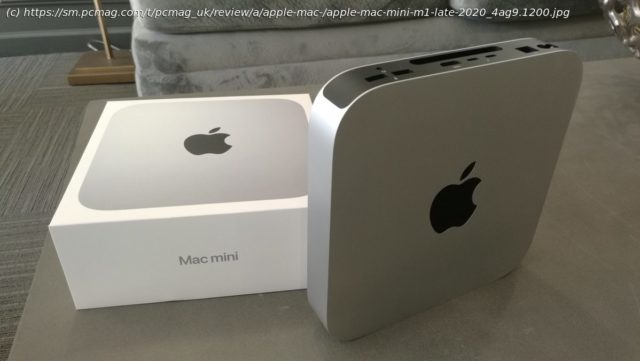Apple’s new M1 chip anchors this A1 mini PC
The Mac mini doesn’t get upgraded often, but when it does, it makes an impact well out of proportion to its trim dimensions. The 2018 Mac mini was a PCMag Editors’ Choice pick for its pep, connectivity, build quality, and limited upgradability. A slight variation on the same sheet music, played with little fanfare earlier this year, pumped up the two base models’ SSD capacity. The real update of this iconic little desktop is this one, and it’s a big-band extravaganza. Apple’s own highly integrated system-on-a-chip (SoC), the M1 brings the Mac mini to new performance highs, and while a few fundamentals have changed, the peppy performance, the reasonable mix of connectivity, and a new lower $699 starting price combine to make it one of the best values in compact computers, period. It easily earns our Editors’ Choice nod. Design: A Familiar Face, an Amped-Up Core The Mac mini remains the only true “small” Mac desktop. Sure, you can still select between 21- and 27-inch iMac models (which we’d expect to gain the M1 CPU before too long, as well). But if you want a compact, macOS-based system that’s not a laptop to attach to a TV, a spare monitor, or even just a public informational display, the Mac mini has long been the Apple alpha and omega. That said, the fact that the Mac mini is equipped to work as anything from an everyday productivity churner, a home theater system, a little music- and video-editing dynamo, or even just a digital-display pusher is testament to this design’s enduring flexibility. It doesn’t take up much space, and it looks good wherever you stash it. The out-of-box experience is as straightforward as can be. The 1.4-by-7.7-by-7.7-inch chassis comes in a plastic wrapper. Under it, a two-socket power cable is coiled with care in an elaborate paper carrier. That trim cord is all the power gear there is; the Mac mini’s power supply is internal. Setup is quick, and can involve porting over key files and apps from another Mac if you’re already in the macOS ecosystem. Once you hit the desktop, you’ll be faced with the new look of macOS, Big Sur, which is one of the biggest switch-ups to the OS in recent years. (For much more on that, see our deep-dive look at Big Sur.) The chassis of the Mac mini hasn’t changed a whole lot since the 2018/early 2020 revision. The body is milled aluminum, with a satin finish, four rounded corners, and no seams in the metal. Only the rear panel is interrupted by ports or buttons, with the full I/O panel out of sight and the power button well hidden on the right rear corner. (You’ll have to get used to locating it by feel.) The only feature visible on any of the other chassis edges is a white pinprick of a power-on LED, on the lower right corner of the front face. As before, the bottom of the body is dominated by a large, black-plastic ring that allows access to the interior for servicing. But Apple notes that this is strictly for its own repair personnel only. There’s no point in prying inside, anyway. Unlike the 2018 Mac mini, the M1-based version incorporates the main system memory into the SoC’s module. As a result, inside the shell, you won’t find any SO-DIMM slots for upgrades as before. The amount of memory you opt for at purchase time, as well as the internal storage amount, are what you’ll have to live with for the life of the system. Configurations: Mac mini Times Two The loadout of the new Mac mini is easy to understand. Apple offers two base models: a $699 lower-storage-capacity model (256GB SSD), and an $899 higher-capacity one (512GB SSD). Each one can be up-configured from the factory with more system memory or storage, however. All SKUs of the Mac mini use the M1 processor, Apple’s custom SoC with eight processing cores, eight graphics cores, and an additional series of cores that Apple dubs a “Neural Engine.” As outlined in our M1 explainer (see What Is the Apple M1 Chip?), the eight processing cores are split into four cores for high performance, and four “efficiency” cores for less-demanding tasks that can be shunted over by macOS for power conservation. This is the same fit-out of the chip as in all of the other initial M1-based Macs, with the exception of the base-model MacBook Air, which employs the M1 but with seven instead of eight GPU cores. This is a drastic change from the earlier Mac minis. Before this M1 CPU switchover, the $799 base-model Mac Mini came with a quad-core Intel Core i3, and the $1,099 step-up version was based on a Core i5, with the option to level up the configuration to a Core i7 for an upcharge. The early-2020 revision of the Mac mini boosted the capacity of the base SSD from 128GB to 256GB in the $799 model, and from 256GB to 512GB in the $1,099 model. No such complications now. Beyond the SSD, the two main configurations of the Mac mini are the same. You get the M1 CPU,8GB of not-user-upgradable “unified” memory (more about that in a moment), and the 256GB or 512GB SSD, depending on the base model you select. Each of the two base models can be kicked up to 16GB of system memory for $200 more. The 256GB base model can be upgraded to a 512GB (+$200),1TB (+$400), or 2TB (+$800) SSD, while the 512GB base model can go to a 1TB (+$200) or 2TB (+$600) SSD. The only other configurables are whether to pre-install Logic Pro or Final Cut Pro on the system. That 16GB memory ceiling may be a curiosity for content-creation pros used to piling on the gigabytes for memory-hogging programs like Adobe Photoshop, and for heavy multitasking. That said, the memory approach with the Apple M1 SoC is completely different from that on earlier Macs. Apple dubs the integration of the memory into the SoC a “unified memory architecture,” the upshot of which ostensibly reduces latency between the SoC’s modules and gives access to the memory, in more direct fashion, to both the CPU and GPU cores. How this affects raw performance will ultimately be hard to separate from our overall benchmark numbers, which are baked, as it were, into the overall performance cake. But we’ll address that holistically in the testing section below. Connectivity: A New Mix The back panel of the M1-based Mac mini is the biggest physical change from the 2018/early 2020 model. Like the lack of internal upgradability, it’s less, not more. You get a dedicated Ethernet jack, two Thunderbolt 3/USB Type-C ports, an HDMI output, two USB Type-A ports, and a combined headphone/mic jack. That’s in contrast to the earlier Mac mini model’s four Thunderbolt 3/USB-C ports.






